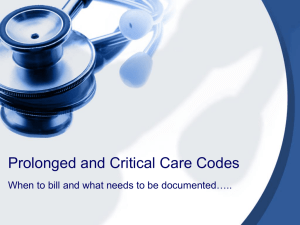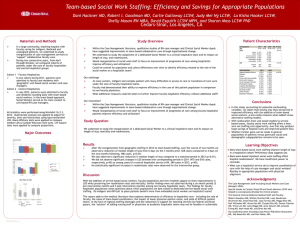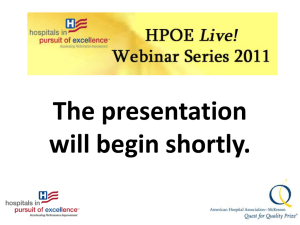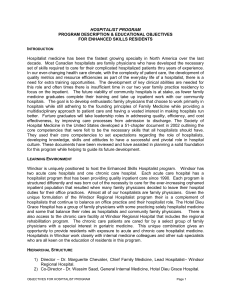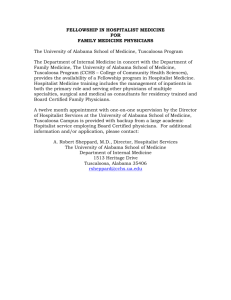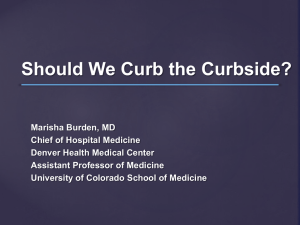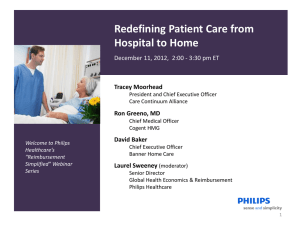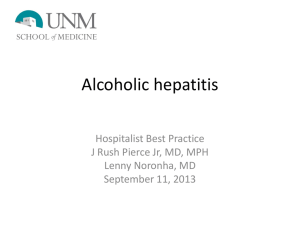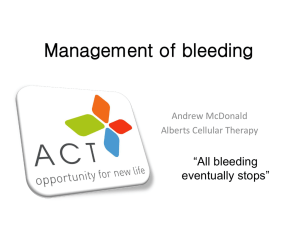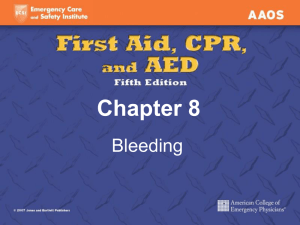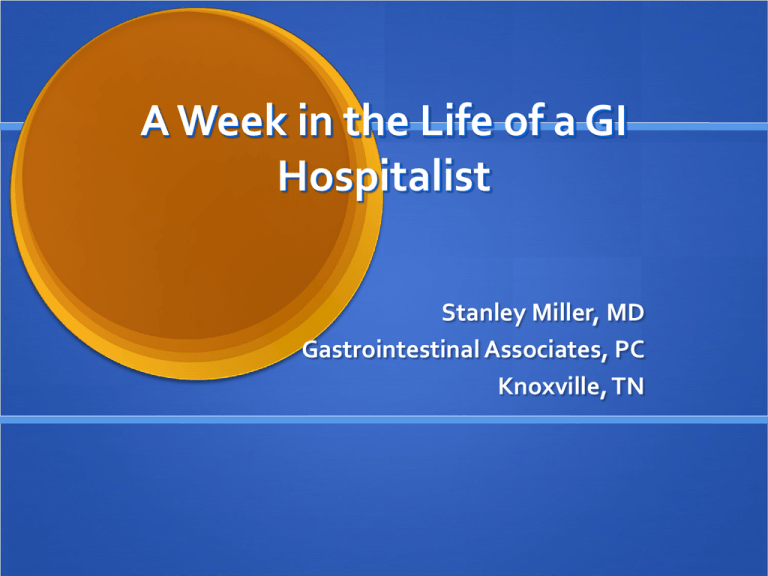
A Week in the Life of a GI
Hospitalist
Stanley Miller, MD
Gastrointestinal Associates, PC
Knoxville, TN
Objectives of Talk
What is a GI hospitalist?
What does Stan Miller do as a GI hospitalist?
How does it affect patient care to have a GI hospitalist?
What does it mean for the GI lab staff and other patient
care personnel to have a GI hospitalist in the hospital?
TSGNA October 2011
Introduction
Started September 1998
Currently 11 Physician GI group
2 nurse practitioners
1 full-time GI hospitalist
Started GI practice in 1989, last 13+ years as GI hospitalist
TSGNA October 2011
Definition of GI Hospitalist
Physicians whose primary focus of care is inpatient
medicine are called hospitalists. (Wikipedia) In my case, I
practice full time gastroenterology on inpatients so I call
myself a GI hospitalist.
TSGNA October 2011
GIA Hospitalist Team
One full time physician
One full time Registered Nurse
One full time nurse practitioner
Splits time at two hospitals, mornings with me at Physicians
Regional Medical Center and afternoons at smaller North
Hospital
TSGNA October 2011
Melanie R.N. and Amy F.N.P
TSGNA October 2011
Objectives of Hospitalist
More efficient use of physician time
More efficient use of hospital GI lab
More efficient use of office and office based
gastroenterologists
Cost savings and improved patient outcomes
TSGNA October 2011
Duties of a GI Hospitalist
See inpatient consults
Round on hospitalized patients with GI issues
Perform specialized hospital based GI procedures (to be
discussed later)
Admit primary GI focused patients
Answer emergency calls
TSGNA October 2011
Job Description Dr. Miller
Monday-Friday 6AM-4PM on call
All night admits, consults held over unless an emergency
consult
No office work
Nights, weekends covered by partners
One holiday a year in rotation
TSGNA October 2011
Job description
I see consults, take calls from ER and patients referred
from office
Round on inpatients for our group daily
All new patients are assigned to office doctor for
outpatient followup as needed
TSGNA October 2011
Hospital based specialized
procedures
ERCP’s, a main area of expertise
200-300 ERCP’s each year
Rare referrals to tertiary centers now
Problem-back up support when I am gone
TSGNA October 2011
Other types of patients
Defibrillator patients
Food impactions
Nursing home patients
Obese, over 400#
Argon plasma coagulation
Balloon dilations
Stents outside biliary tract, ie esophagus
TSGNA October 2011
Hospital expertise
Bleeding of gut is common, adept at clips, cautery,
injection
Numerous foreign bodies removed of all types over the
years
Towels, pens, razors, flossing devices, toenail clippers, coins,
batteries, paper clips, sex toy (unsuccessful) and lots and lots
of meat.
TSGNA October 2011
Hospitalist Contract
Base Salary with guarantee
Productivity based income
Full partnership
4 weeks off per year, work one holiday
Low office overhead, charging for what is used instead of
full share due to lower revenue stream
TSGNA October 2011
Advantages
More efficient use of office ASC
Office M.D.’s with few or no interruptions from hospital,
earlier start at office
Less congestion in hospital GI lab
TSGNA October 2011
Advantages
Hospital M.D. expertise in hospital procedures and
patients such as ERCP’s, bleeding, working with
defibrillators, anticoagulants
Staff knows who to call in hospital for problems
Working relationship with pathology, radiology, Medicine
hospitalists
TSGNA October 2011
Advantages
Hospital likes it due to built in efficiencies of expediting
care, shorter length of stay
Office doctors have less call time
Hospitalist has no nights or weekends
TSGNA October 2011
Impact on Patient Care
Consistent Patient Flow
GI lab staff
Same routines working with me daily
Fewer errors with standard protocols i.e. preop antibiotics for
PEG, biliary obstruction, etc
Scheduling consistencies since usually I perform/function same
way day to day
I learned quirks of GI lab and adapt some also
I have been able to teach as well as learn from my close working
relationship with nurses/techs
TSGNA October 2011
Impact on patient care
Hospital Staff in ICU and on floors
They know who to call for orders, problems
Staff does not have to go through office voicemail jail to find
me
Service and call backs (at least by me) are more prompt and
responsive since I am in the hospital providing patient care
TSGNA October 2011
Impact on Patient care
For Hospital/Administration
Quicker response for procedures
Decreased length of stay.
We showed 0.5 day decrease in length of stay
$400 decrease cost per stay for acute GI bleeding
TSGNA October 2011
Impact on Patient care
For partners of GI hospitalist
Less “on-call” time
More efficient use of time, no lost travel time back and forth
Disadvantage is lose touch on some procedures like ERCP’s
TSGNA October 2011
Impact on Patient care
Patients
Fewer complications due to expertise
Fewer transfers out to tertiary centers
Shorter length of stay
Lower cost
Consistent face to see while in hospital although not always
their primary MD
TSGNA October 2011
Impact on Patient care
For other hospital physicians
They know who to call and what response will be instead of a
different GI consultant each day
Faster service in seeing consults, getting procedures since I
am in house each day
TSGNA October 2011
Disadvantages-Patients
Not able to see usual GI physician
Not able to see GI Hospitalist after discharge from hospital
TSGNA October 2011
Disadvantages-GI Lab Staff
If MD is a jerk, you are stuck day to day with a jerk
TSGNA October 2011
Disadvantages-Hospitalist
Lower reimbursement for hospital patients
Hospitalist burnout
Consults for everything (red jello, pepto bismol)
Unpredictable work load day to day
TSGNA October 2011
The WEEK September 2011
Colonoscopies
9
EGD
Varices banded
1
Foreign Body 1
PEG
3
ERCP
Flexible Sigmoidoscopies
9
Consults
25
Followup Hospital Visits
68
TSGNA October 2011
15
3
Diagnosis for 1 Week
Anemia, GI bleeding, CBD stones, Jaundice, Spontaneous
Esophageal Perforation (2), Duodenal AVM bleeding, Nausea
and vomiting, Diarrhea, Clostridium difficile diarrhea, Infectious
colitis, Colon polyps, Rectal bleeding, Short bowel diarrhea,
Ileus, Pancreatitis, Dysphagia, Pyloric stenosis, Bleeding
duodenal diverticulum, MALT lymphoma, Esophageal stricture,
GE reflux, Post Op Ileus, Heme positive stool, Ischemic colitis,
Esophageal Varices bleeding, Gastroparesis, Stercoral rectal
ulcer bleeding, Foreign body (nail), Diverticular bleed colon,
Crohns colitis, Liver mass, Abdominal Pain, Ascites, Rectal
cancer, Iron deficiency anemia, Liver Failure, Cirrhosis, Acute
Diverticulitis, Abnormal liver tests shock liver. (39 different Dx)
TSGNA October 2011
The Day
6AM-4PM on call officially
6AM-pick up consults from night
6:35AM-ICU rounds
7-8:30AM-see new consults
8:30-midday-procedures
1pm-finish, f/u rounds see more consults as they come in
TSGNA October 2011
THE DAY, scrutinized
Pick up overnight consults, 4
Ischemic colitis
GI bleed, 2 of them
Dysphagia
See ICU patients
3, one esophageal perforation, one massive GI bleed from
ulcer and one abnormal liver tests from sepsis
TSGNA October 2011
The Day, scrutinized, cont.
Procedures
Screening colonoscopy, 1
PEG in cancer patient, 1
Heme positive stool colonoscopy in patient with defibrillator
ERCP with stone removal
Colonoscopy in diverticular bleed patient
Colonoscopy in hospitalized iron deficiency patient
EGD, hematemesis, esophagitis
Sigmoidoscopy, bleeding stercoral rectal ulcer
Esophageal Motility studies, 2, reflux and dysphagia
TSGNA October 2011
The Day, scrutinized, cont.
PM rounds
10 inpatient followup visits
Consult for PEG in demented patient
Consult for anemia
Consult for abdominal pain in chronic narcotic user, 2
Consult for abnormal liver tests
Urgent scope to remove meat bolus
TSGNA October 2011
What type of patients do I see as a
full time GI Hospitalist?
2010 data Top 12 diagnosis
GI bleeding
Dysphagia
Diarrhea
Blood in stool
Iron deficiency anemia
Nausea and vomiting
TSGNA October 2011
What type of patients do I see as a
GI Hospitalist, cont?
2010 data, top 12 diagnosis, cont
Esophageal reflux
Hematemesis
Abdominal pain
Colon polyps
Abnormal liver tests
Bile duct stones (choledocholithiasis)
TSGNA October 2011
Diagnosis of interest
2010 Data
Foreign bodies esophagus
19
Acute pancreatitis
51
Jaundice
33
Obstruction of bile duct, unsp
34
Crohn’s disease
20
Total of 246 total GI diagnosis coded for my encounters on
hospital patients
TSGNA October 2011
What type of procedures do I
perform as a GI Hospitalist?
2010 Data
Upper endoscopies of all types
Percutaneous gastro tubes
PEG exchanges
ERCP’s
Sphincterotomies
Stone removal
Stent placement
TSGNA October 2011
880
113
28
285
117
83
70
Procedures performed
2010 Data
Colonoscopies
367
Only 18 true screening colonoscopies
Sigmoidoscopies
Esophageal motility readings
Hospital consults
Hospital followup visits
TSGNA October 2011
125
93
952
1652
Unusual Consults
Red Jello ostomy output-GI bleed
Black stools-iron or pepto bismol
Razor blade ingestion
Toenail clippers ingested
Sex toy in wrong place
100’s of tiny gallstones entire biliary tree
Marijuana Nausea and Vomiting, Hot Showers/Hot Tub
TSGNA October 2011
Life as a GI Hospitalist
Summary: Why I am a hospitalist
Reasonable hours that are relatively stable
Fix it and move on
Appropriate compensation
Development of niche expertise
Lifestyle choice
TSGNA October 2011
Summary
Objectives met
What a GI hospitalist is and does.
How having a dedicated physician to hospital GI care
improves outcomes
How a GI hospitalist improves patient flow and care in a large
suburban hospital.
THANK YOU
TSGNA October 2011


